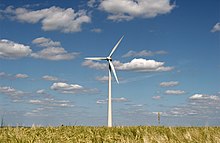Solar power is the generation of electricity from sunlight. This can be direct as with photovoltaics (PV), or indirect as with concentrating solar power (CSP), where the sun's energy is focused to boil water which is then used to provide power. The solar power gained from photovoltaics can be used to eliminate the need for purchased electricity (usually electricity gained from burning fossil fuels) or, if energy gained from photovoltaics exceeds the home's requirements, the extra electricity can be sold back to the home's supplier of energy, typically for credit.[1] The largest solar power plants, like the 354 MW SEGS, are concentrating solar thermal plants, but recently multi-megawatt photovoltaic plants have been built. Completed in 2008, the 46 MW Moura photovoltaic power station in Portugal and the 40 MW Waldpolenz Solar Park in Germany are characteristic of the trend toward larger photovoltaic power stations. Much larger ones are proposed, such as the 550 MW Topaz Solar Farm, and the 600 MW Rancho Cielo Solar Farm. Solar power is a predictably intermittent energy source, meaning that whilst solar power is not available at all times, we can predict with a very good degree of accuracy when it will and will not be available. Some technologies, such as solar thermal concentrators have an element of thermal storage, such as molten salts. These store spare solar energy in the form of heat which is made available overnight or during periods that solar power is not available to produce electricity.
Wind power
Wind power is the conversion of wind energy into a useful form of energy, such as electricity, using wind turbines. At the end of 2008, worldwide nameplate capacity of wind-powered generators was 121.2 gigawatts (GW).[1] In 2008, wind power produced about 1.5% of worldwide electricity usage;[1][2] and is growing rapidly, having doubled in the three years between 2005 and 2008. Several countries have achieved relatively high levels of wind power penetration, such as 19% of stationary electricity production in Denmark, 11% in Spain and Portugal, and 7% in Germany and the Republic of Ireland in 2008. As of May 2009, eighty countries around the world are using wind power on a commercial basis.[2]
Large-scale wind farms are connected to the electric power transmission network; smaller facilities are used to provide electricity to isolated locations. Utility companies increasingly buy back surplus electricity produced by small domestic turbines. Wind energy as a power source is attractive as an alternative to fossil fuels, because it is plentiful, renewable, widely distributed, clean, and produces no greenhouse gas emissions. However, the construction of wind farms is not universally welcomed because of their visual impact and other effects on the environment.
Wind power is non-dispatchable, meaning that for economic operation, all of the available output must be taken when it is available. Other resources, such as hydropower, and standard load management techniques must be used to match supply with demand. The intermittency of wind seldom creates problems when using wind power to supply a low proportion of total demand. Where wind is to be used for a moderate fraction of demand such as 40%, additional costs for compensation of intermittency are considered to be modest.
Geothermal power
Geothermal power (from the Greek roots geo, meaning earth, and thermos, meaning heat) is power extracted from heat stored in the earth. This geothermal energy originates from the original formation of the planet, from radioactive decay of minerals, and from solar energy absorbed at the surface. It has been used for bathing since paleolithic times and for space heating since ancient roman times, but is now better known for generating electricity. Worldwide, geothermal plants have the capacity to generate about 10 gigawatts of electricity as of 2007, and in practice supply 0.3% of global electricity demand. An additional 28 gigawatts of direct geothermal heating capacity is installed for district heating, space heating, spas, industrial processes, desalination and agricultural applications.
Geothermal power is cost effective, reliable, sustainable, and environmentally friendly, but has historically been limited to areas near tectonic plate boundaries. Recent technological advances have dramatically expanded the range and size of viable resources, especially for applications such as home heating, opening a potential for widespread exploitation. Geothermal wells release greenhouse gases trapped deep within the earth, but these emissions are much lower per energy unit than those of conventional fossil fuels. As a result, geothermal power has the potential to help mitigate global warming if widely deployed in place of fossil fuels.
The Earth's geothermal resources are theoretically more than adequate to supply humanity's energy needs, but only a very small fraction of it may be profitably exploited. Drilling and exploration for deep resources costs tens of millions of dollars, and success is not guaranteed. Forecasts for the future penetration of geothermal power depend on assumptions about technology growth, the price of energy, subsidies, and


No comments:
Post a Comment